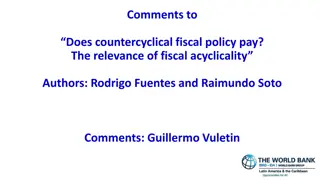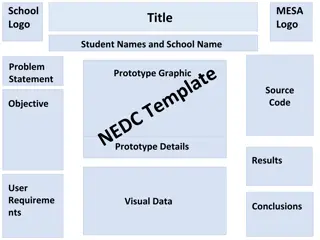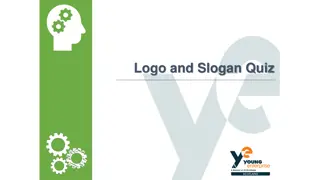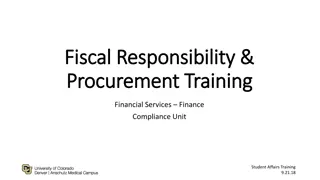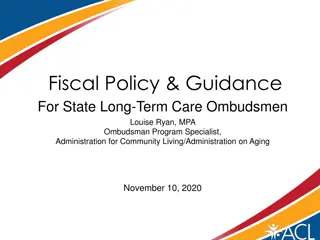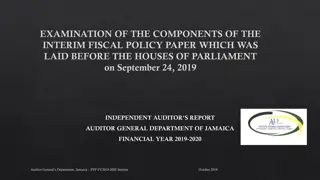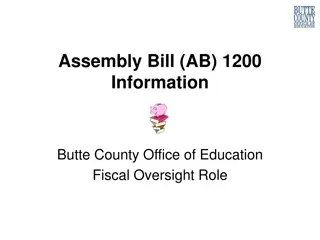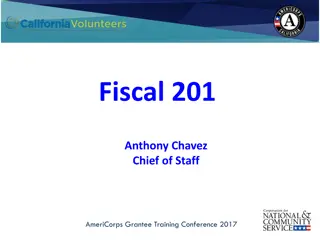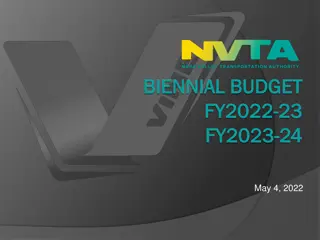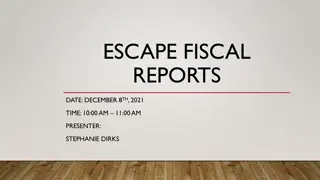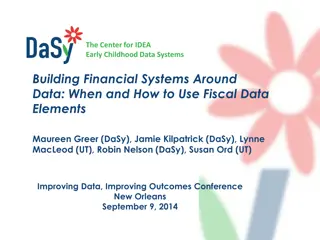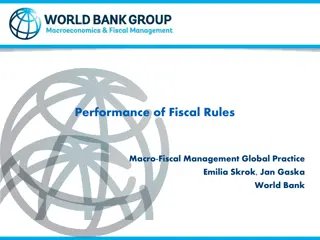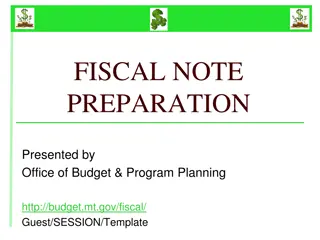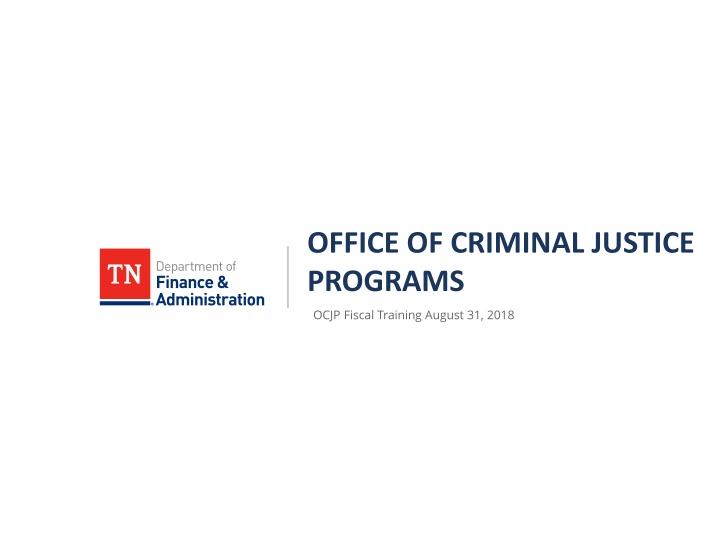
OCJP Fiscal Training Guidelines
Learn about allowable costs, the 20% Rule, prior approval requirements, and budget amendments as outlined in the OCJP Grants Manual for effective financial management in criminal justice programs.
Download Presentation

Please find below an Image/Link to download the presentation.
The content on the website is provided AS IS for your information and personal use only. It may not be sold, licensed, or shared on other websites without obtaining consent from the author. If you encounter any issues during the download, it is possible that the publisher has removed the file from their server.
You are allowed to download the files provided on this website for personal or commercial use, subject to the condition that they are used lawfully. All files are the property of their respective owners.
The content on the website is provided AS IS for your information and personal use only. It may not be sold, licensed, or shared on other websites without obtaining consent from the author.
E N D
Presentation Transcript
OFFICE OF CRIMINAL JUSTICE PROGRAMS OCJP Fiscal Training August 31, 2018
Allowable Costs See Chapter XIV of OCJP Grants Manual and Fund Source Chapters Consistent with organization polices and procedures Must be approved in the budget Must follow federal fund source guidelines Consistent treatment of similar costs Follow generally accepted accounting principles Ordinary and necessary for operation Document methodology Must be allowable, reasonable, and allocable 2
20% Rule See Chapter XVII of the OCJP Grants Manual Agencies can move money within approved budget lines utilizing the 20% Rule; does not require prior approval unless it s a prior approval item like personnel and indirect costs. The 20% must be calculated on both the to and from line. Once a line is increased by 20%, it cannot be increased again. If a line does not already have funding (a zero dollar line) it cannot have money moved to it. Line-item changes include only items that are currently in the agency s approved budget. 20% rule does not apply to the in kind line. 3
20% Rule Example Example: There is $200 in the budget's travel line-item and you want to move more money into the travel line-item. The maximum amount that can be moved into the travel line- item is $40 for the entire fiscal year ($200 x 20% = $40). A separate approved line-item(s) must be reduced by the corresponding $40 and the reduced amount cannot exceed 20% of that line item. NOTE: Do not change column A of the OCJP Invoice for Reimbursement Form. 4
Prior Approval See Chapters XIV, XV, XVII of the OCJP Grants Manual The following budget items must be pre-approved prior to being implemented by the subrecipient: 1. Salary adjustments (including grant funded staff percentages and salary changes) Funds may not be moved into or out of the Salaries, Benefits & Taxes line without prior approval 2. Overtime 3. Staffing Changes if a position is added or deleted from the budget 4. Capital Purchases 5. Depreciation must include a depreciation schedule 6. Sensitive Minor Equipment see Chapter X - Property and Equipment of the OCJP Administrative Manual for further details 7. Furniture 8. Clothing and/or Uniforms (Exception: Emergency clothing for victims/clients does not require prior approval.) 9. Meeting room/audio visual services 10. Indirect Costs Funds may not be moved into or out of Indirect Costs without prior approval. The request must be accompanied by a copy of the agency s approved indirect cost rate or approved cost allocation plan which includes an indirect rate should have approval letter from cognizant agency. 5
Budget Amendments See Chapter XVIII of the OCJP Grants Manual A budget amendment is necessary anytime the total federal funding amount of a grant/contract is increased or decreased and/or if movement of funds between budget line-items is greater than 20 % of the line-item amount. The subrecipient must secure prior written approval from OCJP for all contract budget amendments. The written request must be accompanied by amendment detail and summary budget pages and any related documentation supporting the change. Budget amendments will be considered on a case-by-case basis. 6
Unallowable Costs See Chapter XIV & Fund Source Chapters of the OCJP Grants Manual Construction Land Acquisition Supplanting Compensation and/or travel of federal employees Bonuses or Commissions Military Type Equipment Lobbying Fundraising Corporate Formation State and Local Taxes Certain Conference, Meeting, and Training Expenses 7
Unallowable Conference/Meeting/Training 1. 2. 3. 4. 5. 6. 7. 8. Entertainment Sports Visas Passport Charges Tips Bar Charges/Alcoholic Beverages Laundry Charges Lodging costs in excess of Federal per diem. For events of 30 or more participants that are funded with an OCJP award, if lodging costs exceed the Federal per diem, none of the lodging costs are allowable, effective January 1, 2001. Food and beverage costs are rarely allowable. 10. Gifts/Trinkets/Memorabilia/Commemorative Items 9. Trinkets (items such as hats, mugs, portfolios, t-shirts, coins, gift bags, etc., regardless of whether they include the conference name or OJP/DOJ or OCJP logo) must not be purchased with DOJ or OCJP funds as giveaways for conferences. Basic supplies that are necessary for use during the conference (e.g., folders, name tags) may be purchased. 8
Other Unallowable Expenses 1. 2. 3. 4. 5. 6. Legal fees Cost in applying for this grant Any expenses prior to the grant award date First Class Travel Management and administrative training Sole source contracts (without the prior written approval from the Office of Criminal Justice Programs) Depreciation or a use allowance on idle or excess facilities. Cost incurred outside the project period. Any costs that are incurred either before the start of the project period or after the expiration of the project period are not allowable. Severance packages (the compensation that an employer provides to an employee who has been laid off, whose job has been eliminated, who through mutual agreement has decided to leave the company, or who has parted ways with the company for other reasons). 10. Interest 11. Credit Card Fees 12. Membership fees to organizations whose primary activity is lobbying. 7. 8. 9. 9
Audit Threshold See Chapter V of the OCJP Grants Manual Nongovernmental agencies who expend at least $750,000 under a state contract which establishes a subrecipient relationship (which may include federal pass-through awards) during a year are required to have an audit (not just audited financial statements). Audit costs not performed in accordance with the appropriate OMB Circular, are unallowable. If the subrecipient expended Federal funds less than the amount required for an audit and still elected to contract with a certified public accountant to perform an audit; these costs may not be charged to the federal grant(s). If an agency meets the audit threshold and is required to have an audit, prorated audit costs would be considered an allowable cost. The total cost of the audit would need to be allocated across fund sources using a fair and equitable method. 10
Supplanting See Chapter XV of the OCJP Grants Manual Federal funds must be used to supplement existing State and local funds for program activities and must not supplant those funds that have been appropriated for the same purpose. If reviewers think that supplanting may have occurred, then the applicant or recipient will be required to supply documentation demonstrating that the reduction in non-Federal resources occurred for reasons other than the receipt or expected receipt of Federal funds. For certain programs, a written certification may be requested by the awarding agency or recipient agency stating that Federal funds will not be used to supplant State or local funds. 11
Supplanting Example To help clarify the difference between supplementing and supplanting, we provide the following example: State funds are appropriated to hire 50 new police officers, and Federal funds are awarded for hiring 60 new police officers. At the end of the year, the State has hired 60 new police officers, and the Federal funds have been exhausted. The State has not used its funds towards hiring new officers, but instead reduced its appropriation for that purpose and assigned or appropriated the funds to another purpose. In this case, the State has supplanted its appropriation with the Federal funds. If supplanting had not occurred, 110 new officers would have been hired using Federal funds for 60 officers and State funds for 50 officers. 12
Supplanting cont. Keys to avoiding a supplanting violation: 1) Hire or purchase only new, additional personnel or equipment/technology, and/or other approved costs; 2) Pay only for personnel hired, equipment purchased, and/or other approved costs incurred on or after the award start date; and 3) Make sure the grant-funded purchases or hires are over and above the number of positions, equipment, and/or other approved costs that otherwise would have been funded by the grantee 13
Match See Chapter III of the OCJP Grants Manual Match can be cash or in-kind Match is restricted to the same use of funds as allowed for the Federal funds. Match must be directly related to the project goals and objectives and must be documented in the same manner as grant funded activities. Match cannot be from another federal source. Cash match is budgeted in the line in which it is expended not in the in kind line. For example, if the cash match was used for supplies, it should be reported on that line of the reimbursement invoice; if it was used for specific assistance, it is budgeted in that line and so on. Cash match must be documented, verifiable and used for allowable costs. Cash match must be reported on the reimbursement invoice. 14
In Kind Match Examples: Donations of expendable equipment, supplies, space, value of time contributed by volunteers if the services they provide are an integral and necessary part of a funded project Cannot be counted as match until it is used in the project (for example, goods given to a client). Value placed on donated labor must be consistent with rate of compensation for similar work and must be documented in the same manner as paid staff (signed time sheets). Value placed on donated space must be consistent with fair market value and documented (at least 3 comps from Realtors - use average) Only space that is 100% donated will be considered for match purposes Document methodology for value placed on donated goods (Goodwill) 15
In Kind Match Test Agencies with in-kind match can only draw down in-kind in relation to direct expenses. In other words, you can not overmatch. For example, if your YTD direct expenses are at 85% of the amount budgeted and your in-kind is at 100%, then you have overmatched. Each reimbursement invoice has an in-kind match test above the signature line. If this number is negative, it means you have overmatched. This number cannot be negative on the final reimbursement invoice. It notes on the May invoice that the number cannot be negative the next month. Below is how this appears on the May reimbursement invoice: As you can see here, the number is negative so the agency has overmatched by $12,081.53 and must bring that to zero on the June invoice or the State will reduce the June invoice by this amount. 16
Purchasing Policies All non federal entities were required to be in compliance with the Uniform Guidance purchasing policies by FY18. Code of Conduct and purchasing guidelines begin with CFR 200.318. Highlights include: Code of Conduct (2 CFR, sections 200.318[c][1] and 400.2; Develop a code of conduct that addresses conflicts of interest Gratuities, Favors, or Gifts (2 CFR, sections 200.318[c][1] and 400.2): Include a prohibition on soliciting or accepting gratuities, favors, or anything of monetary value from contractors, potential contractors, or parties to sub agreements. Suspension and Debarment (2 CFR, Appendix II, Section [H]): Include instructions that disallow entering into a contract with parties that have been debarred or suspended, and how staff make that determination. Small and Minority Businesses, Women Business Enterprises, and Labor Surplus Area Firms (2 CFR, Section 200.321): Describe the affirmative process to ensure that minority businesses, women business enterprises, and labor surplus area firms are used when possible. 17
Purchasing Highlightscontinued Micropurchase Procedures (2 CFR, Section 200.320[a]): Describe the process for procuring goods and/or services when the dollar amount does not exceed $3,500 per procurement transaction. (Only required if you choose to use micropurchase.) Small Purchase Procedures (2 CFR, Section 200.320[b]): Describe the process for procuring goods, and/or services when the total dollar amount is less than your agency s relevant small purchase threshold per procurement transaction. Formal Purchase Procedures (2 CFR, Section 200.320[c] and [d]): Describe the process for procuring goods and/or services when the dollar amount is more than your agency s relevant small purchase threshold per procurement transaction. Noncompetitive Procurement (2 CFR, Section 200.320[f]): Describe the process for procuring goods and/or services that cannot be conducted through normal competitive procurement methods, including emergency or sole source procurement. 18
Purchasing Highlights Continued Cost and Price Analysis (2 CFR, Section 200.323): Describe the process for performing a cost or price analysis for every procurement action in excess of the small purchase threshold (phone bids, 3 quotes, etc). Clear Description (2 CFR, Section 200.319[c][1]): Describe staff requirements and required components for writing a clear description of the material, product, or service to be procured. 19
Cost Allocation Process to determine total cost of a project Distribute costs to a project Cost allocation plan includes both direct and indirect costs The cost allocation plan must include plans for allocation of allocable direct costs as well as administrative costs. Total Costs = allowable direct and allocable indirect costs 20
Allocable Costs See Chapter XIV of the Administrative Manual and 2 CFR 200 Accordance with relative benefit Specific to project Benefits multiple projects Reasonable distribution 21
Direct Costs Specific to a project Cannot be assigned to other projects such as salaries, travel that benefits a specific program, equipment 22
Indirect Costs Common or joint benefit to multiple projects Costs remaining after assigning direct costs Cannot be allocated if similar cost assigned to a project Must still follow allowable costs 23
Examples of Indirect Costs Depreciation of buildings and equipment (Rent and fixed asset computers) Operation and maintenance facilities (Utilities, service agreements, insurance) Administrative salaries and expenses (Administrative and financial staff) Legal services 24
Allocation Bases Employees Space/Square Footage Salaries and Wages 25
Indirect Cost Rate Indirect Cost Rate (%) = Total Indirect Costs ($) Direct Cost Base ($) Indirect Costs are fixed Small Base = Large Rate Large Base = Small Rate Agency must submit a cost allocation plan to their cognizant state agency for approval before indirect costs can be charged to OCJP grants. The cost allocation plan must include the indirect cost rate and method used to arrive at the rate. 26
Indirect Cost Rate Example Indirect Costs = $500,000 Direct Salaries & Wages = $2,000,000 Indirect Rate: $500,000 = 25% $2,000,000 27
Best Practices Use consistent and reasonable method Identify and charge direct expenses whenever possible Identify primary cost drivers of indirect cost (salary vs. space) Document allocation methodology Allocate appropriate expenses; any unallowables must be removed The same costs that have been treated as indirect costs can not be claimed as direct costs. Similar types of costs must be accounted for consistently. 28
Items to Include when Submitting Cost Allocation Plan Organization Chart Cost Policy Statement describing accounting policies and narrating in detail the proposed Cost Allocation Plan. This plan must describe the procedures used to identify, measure and allocate all costs to each benefiting activity. Financial statements (audited if available) for the applicable fiscal year. Personnel Costs Worksheet including fringe benefits breakdown. Include allocation of personnel showing direct/indirect time charges. A listing of all grants and contracts, program office funding source, total dollar amount, period of performance, and the indirect cost limitations (if any) applicable to each. Must be signed by authorized official. 29
Reporting Requirements See Chapter VII of the Administrative Manual Report Required Organization Reporting Period Date Due to OCJP Reimbursement Invoice All Prior Month/Quarter At least quarterly; prefer monthly. Submit online by July 31stif equipment was purchased during the reporting period Project Equipment Summary Report All July 1 June 30 Program Income Summary Report Government & Educational Institutions Quarter Ending: September 30 December 31 March 31 June 30 Submit online by: October 15th January 15th April 15th July 31st Policy 03 Quarterly Expense & Revenue Report Please include agency name and reporting quarter in the email subject Non-Profits Quarter Ending: September 30 December 31 March 31 June 30 Submit to OCJP.P3@tn.gov by: October 30th January 30th April 30th July 31th Annual Fiscal Audit or Financial Report Non-Profits Agency fiscal year Due 9 months after close of agency fiscal year 30
Policy 03 Reporting Link to report in Reporting Section of online grants manual Required for all non profit agencies Report is due 30 days after the end of each quarter Has tabs for expenses, revenues, and agency wide expense summary The final column on Schedule C should trace to the agency total general ledger All state grants should be reported on the same Policy 03 report; 1 report sent to all state funders For OCJP, email the quarterly Policy 03 report to OCJP.P3@tn.gov 31
Other Training Opportunities https://cfo.gov/grants/training/ Go to Module 4 www.tn.gov/ocjp Go to Grants Management Resources and then OCJP Financial Grants Management Training 32
OCJP Fiscal Unit Contact Information If you have questions, feel free to contact one of the fiscal staff listed below: Wendy.Heath@tn.gov or 615-741-9821 Teresa.Sneed@tn.gov or 615-626-7495 Jennifer.Hicks@tn.gov 33

